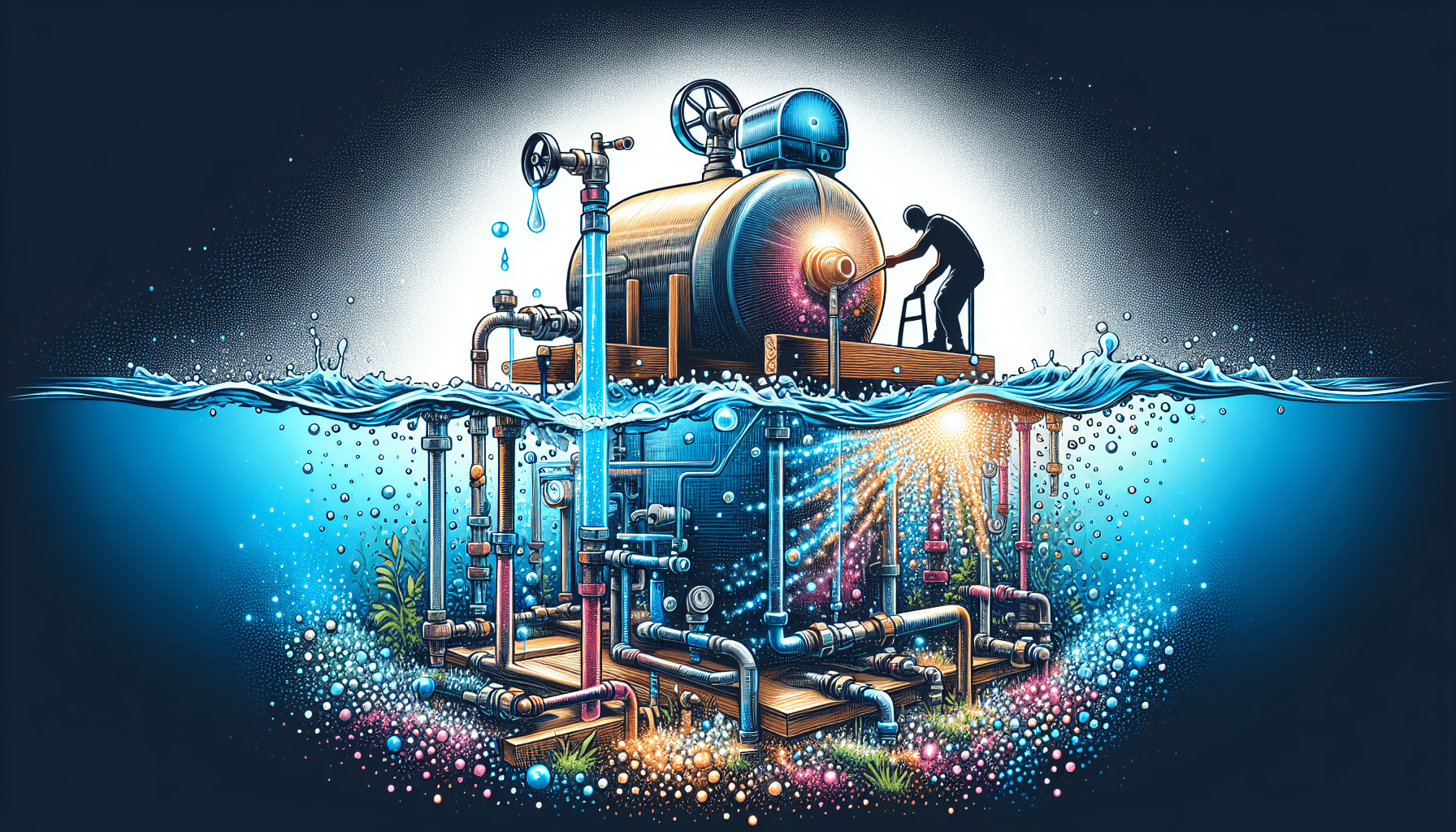In this informative article, we will explore the safety considerations that need to be taken into account when it comes to well water in areas with well water pressure tank maintenance strategies. With increasing reliance on well water for households, it is crucial to understand the potential risks and how to mitigate them. By examining the importance of regular maintenance, the impact of water quality on safety, and the necessary precautions to ensure the well water remains free from contaminants, you will gain valuable insights into how to keep your well water safe and secure for everyday use.
Introduction
Having access to a reliable and clean water supply is essential for the health and well-being of every individual. In many areas, well water is the primary source of water for households. While well water can be a safe and sustainable option, it is crucial to prioritize its safety and understand the potential risks associated with untreated well water. In this article, we will discuss the importance of well water safety, explore various maintenance strategies for well water pressure tanks, consider safety considerations for well water, identify signs of well water contamination, and discuss ways to ensure a safe well water supply. By implementing these measures and educating well owners, we can ensure the availability of clean and safe well water.
Importance of Well Water Safety
Potential risks associated with untreated well water
Untreated well water can pose several risks to your health. Contaminants such as bacteria, viruses, and chemicals can find their way into the water supply, resulting in various health issues. These contaminants can enter the well water through natural sources, such as groundwater contamination, or from human activities like improper waste disposal or agricultural runoff. It is crucial to recognize the potential risks associated with untreated well water to ensure the safety of your household.
Benefits of ensuring well water safety
By prioritizing well water safety, you can reap numerous benefits. Clean and safe well water reduces the risk of waterborne illnesses, stomach infections, skin irritations, and other health concerns. Properly maintained well water can also enhance the quality of your daily activities, such as cooking, drinking, and bathing. Additionally, safe well water contributes to the overall well-being of your household and provides peace of mind knowing that you have a reliable and healthy water source.

Well Water Pressure Tank Maintenance
Understanding well water pressure tanks
Well water pressure tanks play a crucial role in maintaining the water pressure and supply in your home. These tanks are responsible for storing and pressurizing the water that comes from your well. The pump inside the tank helps to regulate the water pressure and ensure a consistent flow. Understanding the basics of well water pressure tanks is essential for their proper maintenance and ensuring the safety of your well water supply.
Importance of regular maintenance
Regular maintenance of well water pressure tanks is vital to ensure their optimal performance and longevity. Over time, pressure tanks can develop issues such as leaks, accumulated sediment, or a loss of pressure. Regular inspections and maintenance can help identify these problems early on and prevent potential water contamination or damage to the system. By scheduling routine maintenance, you can avoid costly repairs and help extend the lifespan of your well water pressure tank.
Common maintenance strategies
Several maintenance strategies can help ensure the safe operation of well water pressure tanks. These include checking the pressure levels, inspecting for any signs of damage or leaks, cleaning or replacing filters, and draining the tank to remove accumulated sediment. It is also important to monitor the overall performance of the pressure tank, such as any changes in water pressure or unusual noises. Regularly consulting with a professional well water contractor can provide valuable guidance on maintenance procedures specific to your tank and ensure the safety and efficiency of your well water system.
Safety Considerations for Well Water
Testing well water quality
Regular testing of well water quality is an essential safety consideration. Testing helps identify any potential contaminants in the water supply, such as bacteria, viruses, heavy metals, or excessive levels of minerals. It is recommended to test the well water at least once a year, or more frequently if there are any changes in the water’s taste, appearance, or odor. Testing should cover parameters such as pH levels, total dissolved solids (TDS), nitrates, and any specific contaminants relevant to your region. Testing well water quality provides valuable information to ensure the safety and purity of your drinking water.
Identifying potential contaminants
Identifying potential contaminants in well water is crucial for maintaining a safe supply. Common contaminants found in well water include bacteria, such as E. coli, coliforms, or fecal bacteria, as well as chemicals like pesticides, fertilizers, or volatile organic compounds (VOCs). Regular testing can help pinpoint these contaminants, allowing for appropriate treatment measures to be implemented. By understanding the potential contaminants that may affect your well water, you can take the necessary steps to ensure its safety.
Implementing water treatment solutions
If contaminants are found in your well water, implementing water treatment solutions is vital to ensure its safety. Depending on the specific contaminants present, treatment options may include disinfection methods such as chlorination or ultraviolet (UV) light, filtration systems to remove suspended particles, or specialized treatment processes for removing specific chemicals or heavy metals. Assessing the test results and consulting with water treatment professionals can guide you in selecting the most appropriate and effective treatment solutions for your well water.

Signs of Well Water Contamination
Changes in water appearance, color, or taste
Any noticeable changes in the appearance, color, or taste of well water can indicate potential contamination. If the water suddenly becomes discolored, cloudy, or has a strange taste, it is important to investigate and take immediate action. These changes can be indicative of contaminants, such as iron, manganese, sulfur, or other impurities, which may require treatment to restore the water’s quality. Being vigilant about changes in your water’s characteristics allows you to promptly address any issues and maintain the safety of your well water supply.
Presence of foul odor in the water
A foul odor in well water should raise concerns regarding potential contamination. Odors like rotten eggs (sulfur), chlorine, or a musty smell can indicate the presence of bacteria, hydrogen sulfide, or other chemical contaminants. While certain odors may be harmless, it is important to address persistent or unusual odors by testing the water and implementing appropriate treatment measures. By addressing foul odors in your well water, you can ensure the safety and quality of the water your household uses every day.
Health symptoms after consuming well water
If you or anyone in your household experiences health symptoms, particularly gastrointestinal issues, after consuming well water, it could be an indication of well water contamination. Symptoms such as diarrhea, nausea, stomach cramps, or skin irritations could be related to waterborne illnesses or exposure to contaminants present in the well water. Promptly seeking medical attention and testing the well water can help identify the potential sources of contamination and allow for appropriate treatment measures. Paying attention to any health symptoms can help safeguard your well water supply and protect the health of your household.
Ensuring Safe Well Water Supply
Installing a backflow prevention device
Installing a backflow prevention device is an important safety measure to protect your well water supply. Backflow occurs when the flow of contaminated water reverses, allowing contaminants to enter the main water supply. A backflow prevention device prevents this by ensuring that water flows in one direction only, from the well to your taps. By installing a backflow prevention device, you can reduce the risk of cross-contamination and maintain the safety of your well water supply.
Maintaining proper well construction standards
Ensuring proper well construction is crucial for a safe well water supply. A professionally constructed well should have a sealed casing, proper grouting, and a sanitary seal to prevent contamination from surface waters, shallow groundwater, or other potential sources. Regular inspections and maintenance can help identify any issues with the well’s construction and address them promptly. By adhering to proper construction standards, you can minimize the risk of contamination and maintain a safe and reliable well water supply.

Educating Well Owners
Importance of well water safety awareness
Educating well owners about well water safety is essential for promoting a culture of awareness and responsible water management. Well owners should be informed about the potential risks of untreated well water, the importance of regular testing and maintenance, and the necessary steps to ensure its safety. Increasing well water safety awareness helps individuals make informed decisions, adopt best practices, and take appropriate action to safeguard their water supply. By providing comprehensive information and encouraging a proactive approach, well owners can actively contribute to the safety of their well water.
Providing resources and information
To support well owners, it is crucial to provide accessible resources and information on well water safety. This can include educational materials, guidelines on well maintenance, contact information for local well water professionals, and details on available testing and treatment options. Collaborating with local authorities, health departments, or community organizations can help distribute these resources effectively. By equipping well owners with the necessary knowledge and resources, we empower communities to take ownership of their well water safety and ensure a clean and healthy water supply.
Emergency Preparedness
Developing a well water emergency plan
Having a well water emergency plan in place is essential for preparedness and quick response in unforeseen situations. Your plan should include steps to take during emergencies such as natural disasters, power outages, or system failures that can affect your well water supply. Consider having backup water storage containers, a generator for powering the well pump, and knowledge of alternative water sources in case of emergencies. Regularly reviewing and updating your emergency plan ensures that you are well-prepared to address any disruptions in your well water supply.
Regularly testing well water for potential risks
In addition to routine testing, regularly testing your well water for potential risks is crucial. This proactive measure allows you to identify any contamination or changes in water quality promptly. Regular testing can also help detect any emerging pollutants or changes in the surrounding environment that may affect your well water supply. By incorporating regular testing as part of your routine, you can ensure the ongoing safety and quality of your well water, providing peace of mind in times of emergency or uncertainty.

Regulations and Guidelines
Local and national well water safety regulations
Well water safety is often regulated by local and national authorities to protect public health. These regulations set standards for well construction, maintenance, and water quality testing. Familiarize yourself with the well water safety regulations specific to your region, including any permits or certifications required. By adhering to these regulations, you can ensure compliance and contribute to the overall safety of your well water supply.
Following recommended guidelines for well water testing and treatment
In addition to regulations, following recommended guidelines for well water testing and treatment is essential. Organizations such as the Environmental Protection Agency (EPA) and local health departments provide guidelines on testing frequencies, treatment methods, and acceptable levels of contaminants. By following these guidelines, you can stay informed about best practices and ensure the effectiveness of your well water testing and treatment efforts. Regularly updating your knowledge and practices will help you stay ahead of any potential safety concerns and maintain a safe well water supply.
Conclusion
Ensuring the safety of your well water supply is crucial for the well-being and health of your household. By understanding the potential risks associated with untreated well water, maintaining well water pressure tanks, and implementing proper safety considerations, you can safeguard your water supply. Regular well water testing, identification of contaminants, and appropriate treatment solutions play a vital role in maintaining clean and safe well water. By educating well owners, promoting emergency preparedness, and adhering to regulations and guidelines, we can collectively contribute to the provision of clean and reliable well water. Remember, prioritizing well water safety is not only essential for your household but also a responsibility towards the community and the environment.

